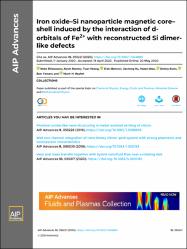| dc.contributor.author | Elhalawany, Noha | |
| dc.contributor.author | Mantey, Kevin | |
| dc.contributor.author | Hoang, Tuan | |
| dc.contributor.author | Bahçeci, Ersin | |
| dc.contributor.author | Xu, Jiacheng | |
| dc.contributor.author | Ateş, Hakan | |
| dc.contributor.author | Gorin, Dmitry | |
| dc.contributor.author | Yamani, Zain | |
| dc.contributor.author | Nayfeh, Munir H. | |
| dc.date.accessioned | 2020-12-15T11:43:36Z | |
| dc.date.available | 2020-12-15T11:43:36Z | |
| dc.date.issued | 2020 | en_US |
| dc.identifier.citation | Elhalawany, N., Mantey, K., Hoang, T., Bahceci, E., Xu, J., Ates, H., Gorin, D., Yamani, Z., Nayfeh,
M.H. (2020). Iron oxide-Si nanoparticle magnetic core-shell induced by the interaction of d-orbitals of Fe2+ with
reconstructed Si dimer-like defects. AIP Advances, 10 (5), art. no. 055221.
https://doi.org/10.1063/1.5144880 | en_US |
| dc.identifier.uri | https://doi.org/10.1063/1.5144880 | |
| dc.identifier.uri | https://hdl.handle.net/20.500.12508/1505 | |
| dc.description.abstract | Redox-type charge exchange between Si nanoparticles and aqueous metal ions m(x+) was recently used to synthesize core-shell nanocomposites in which their functionalities have been integrated. The process requires the electron (hole) affinities of the two to be different, with the efficiency of the charge exchange being strongly dependent on their difference. In this paper, we examine the interaction of Fe ions and red luminescent Si nanoparticles where the metal ion has comparable electron affinity to that of the Si nanoparticle. Scanning electron microscopy and fluorescent spectroscopy imaging show the formation of red luminescent core-shell clusters ranging from 100 nm to 500 nm. A permanent magnet is found to pull the structures indicating the formation of a magnetic phase. We use first principle atomistic computations at the unrestricted Hartree-Fock-DFT (density functional theory) level to obtain the charging energies and affinities of various ions of Fe and the Si nanoparticle. The computations indicate that Fe2+ cannot be oxidized to Fe3+ by the nanoparticle and it cannot strip one or two electrons from the nanoparticle and freely separate, resulting in bound complexes. Our analysis shows that a magnetic phase of iron oxide results from charge delocalization over the complex and a simultaneous interaction of the iron d-orbitals with the oxygen's lone electrons and the nanoparticle's reconstruction dimer-like defects. The core-shell integration at the nanoscale affords double functionality of luminescence and magnetism enhancing sensing, tracking, and delivery and enabling a variety of applications, including controlled drug delivery, underground oil and water exploration, and recovery. | en_US |
| dc.language.iso | eng | en_US |
| dc.publisher | American Institute of Physics Inc. | en_US |
| dc.relation.isversionof | 10.1063/1.5144880 | en_US |
| dc.rights | info:eu-repo/semantics/openAccess | en_US |
| dc.subject.classification | Nanoscience & Nanotechnology | |
| dc.subject.classification | Materials Science | |
| dc.subject.classification | Multidisciplinary | |
| dc.subject.classification | Physics | |
| dc.subject.classification | Applied | |
| dc.subject.classification | Silicon | Quantum Dots | Photoluminescence | |
| dc.subject.other | Zeta valence quality | |
| dc.subject.other | Basis-sets | |
| dc.subject.other | Charge transfer | |
| dc.subject.other | Defects | |
| dc.subject.other | Density functional theory | |
| dc.subject.other | Electron affinity | |
| dc.subject.other | Electrons | |
| dc.subject.other | Fluorescence imaging | |
| dc.subject.other | Iron oxides | |
| dc.subject.other | Metal ions | |
| dc.subject.other | Metal nanoparticles | |
| dc.subject.other | Metals | |
| dc.subject.other | Nanomagnetics | |
| dc.subject.other | Permanent magnets | |
| dc.subject.other | Petroleum prospecting | |
| dc.subject.other | Scanning electron microscopy | |
| dc.subject.other | Shells (structures) | |
| dc.subject.other | Silicon | |
| dc.subject.other | Synthesis (chemical) | |
| dc.subject.other | Targeted drug delivery | |
| dc.subject.other | Aqueous metal ions | |
| dc.subject.other | Charge delocalization | |
| dc.subject.other | Charging energies | |
| dc.subject.other | Core-shell clusters | |
| dc.subject.other | Core-shell nanocomposites | |
| dc.subject.other | Fluorescent spectroscopy | |
| dc.subject.other | Si nanoparticles | |
| dc.subject.other | Unrestricted Hartree-Fock | |
| dc.subject.other | Controlled drug delivery | |
| dc.title | Iron oxide-Si nanoparticle magnetic core-shell induced by the interaction of d-orbitals of Fe2+ with reconstructed Si dimer-like defects | en_US |
| dc.type | article | en_US |
| dc.relation.journal | AIP Advances | en_US |
| dc.contributor.department | Mühendislik ve Doğa Bilimleri Fakültesi -- Metalurji ve Malzeme Mühendisliği Bölümü | en_US |
| dc.identifier.volume | 10 | en_US |
| dc.identifier.issue | 5 | en_US |
| dc.relation.publicationcategory | Makale - Uluslararası Hakemli Dergi - Kurum Öğretim Elemanı | en_US |
| dc.contributor.isteauthor | Bahçeci, Ersin | |
| dc.relation.index | Web of Science - Scopus | en_US |
| dc.relation.index | Web of Science Core Collection - Science Citation Index Expanded | |
















